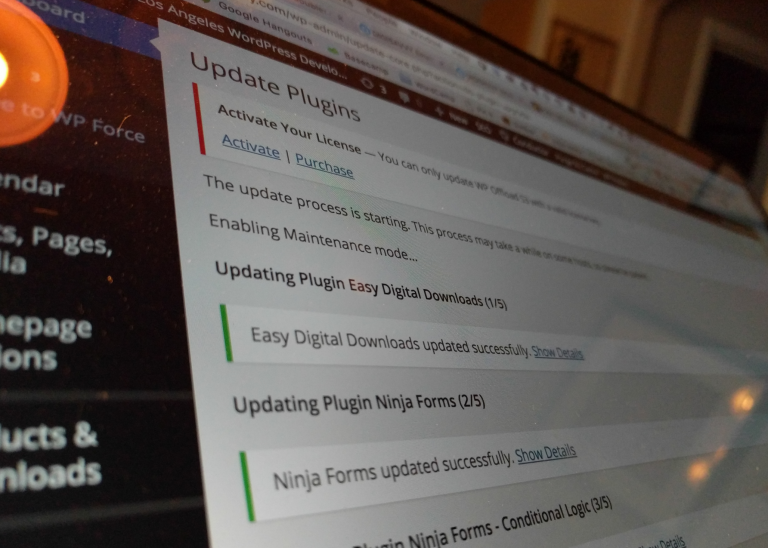Why You Shouldn’t Worry About Bounce Rate

Yeah, you heard me. Don’t worry about your friggin’ bounce rates. But anything having to do with pretty much anything relies on being able to measure a thing against effort put into that thing. What?? More succinctly: If you’re going to do something, make sure it’s trackable and measurable so you know what to improve later on.
Bounce rates indicate a number of things about a website. A high bounce rate can indicate that people are landing on your content, but just leave because they don’t really care about what they found, the information is irrelevant to them. Another thing that a high bounce rate can indicate is that visitors are not clicking on your calls-to-action or otherwise are uninterested in taking further action with your website. On top of that, visitors may think your site is a bucket of vomit and want out right away…
We have a client who has recently asked us to dig into their analytics and try to define the good and the bad in the figures they see; they ultimately want an understanding of what is good and what is not good about their site. Understandable right?
Why do they care about bounce rate anyway? First, let’s take a look at what bounce rate is and why it’s important and why you should pay attention to it:
Bounce Rate is the percentage of single-page sessions (i.e. sessions in which the person left your site from the entrance page without interacting with the page).
With this definition in mind we have a very simple definition what constitutes a bounce rate. After looking into my client’s analytics, I wasn’t quite convinced that their high bounce rates were so much a problem as they were thinking. Let’s take a look.
Yikes! Am I right? With a bounce rate hovering around 90% it certainly causes me to raise and eyebrow and take a look into why the bounce rate is that high and try to determine any contributing factors to that figure.
After poking around, I didn’t see anything that was off; the site response hover around 2 to 3 seconds. Not super great, but also not horrible. So if site speed isn’t the issue, what are some other reasons people might be bouncing.
The website in question get’s a couple thousand page views a day. So they definitely get a decent amount of traffic from a few different sources.
As we can see here, this is just the Analytics traffic acquisition overview. Simply, this tells us which sources are driving the most traffic, with the added benefit of seeing the bounce rate for each source. Email-based traffic (from their weekly subscriber email) has the lowest bounce rate. Why? Those are folks who “opted-in” to get a weekly digest of content; those folks are more invested in the content, thus are more likely to poke around and see what’s what. Also, while Referral Traffic is high, it’s still lower than the Organic Search figure.
Referral traffic are simply visits generated by back-links created on other websites. Someone went to a page, saw something they liked, found that link and thought it might be related so they checked us out. Organic search is just that, regular old searches in Google or elsewhere that produce a list of results and at least one of the results brought a user back to the site.
Why is Organic Search Bounce Rate So High?
Your guess is as good as mine here. Simply, when a person searches something they’ll get possibly related results; they click the first few results, or maybe just one of them; they consume the content and if it’s related, they stay and read. Or if it’s not, they leave “bounce off.” Applying.
If we were to brain-storm as to what’s going on with high bounce rates, I would offer up the following scenarios:
- Bounce rate is high because the content IS RELEVANT and after that, the user has consumed the content and wants to get out. How many of us do that? *raises hand*.
- Bounce rate is high because the content is NOT relevant. If that’s the case, how can we make sure that the content is more relevant to people hitting the page? Using a tool like Hittail can help you figure out some organic search phrases of folks coming to your site and see if you can come up with more relevant content.
- Your bounce rate sucks because your website is shit. Yes, your site could be shit and that’s something you need to deal with.
– Poor load times. If your site loads slowly, you should improve site speed
– Bad user experience. If your site is hard to navigate, has too many ads, or is slow, you’re fighting an uphill battle. Work with someone to fix it; better yet, get a website audit to see what can be done to improve things.
– Few or no calls to action or relevant links related to your content. Again, a website audit would aid you here. But placing relevant content links is super useful and helps provide greater value and context by providing related content to stuff people are already reading.
One of the contentions I have with the “high bounce rates are bad” argument is that it doesn’t take into account how engaged a reader of the specific content is. What if the visitor DOES get what they want and they just leave. That IS an actual bounce, by the very definition. But if the user is engaged, what do we do about that? Enter the ‘Adjusted Bounce Rate‘ metric.
“ABR” is great because it provides some value and insight for your bounces; the figure can be seen in analytics and should at least make you feel better about life. Implementing Adjusted Bounce Rate isn’t too hard. The link I provided above has steps for how to implement yourself. If you’re someone running a WordPress site, then there’s a plugin for that. Also easy to implement and all you need to do is wait a day and see how things pan out.
I recently made this change for my client’s analytics to see what their ABR will look like. Check back soon to see the stats!
So should you worry about bounce rate? As long as your site isn’t a heaping slow mess that frustrates people, I think you can ignore it. Many blogs tend to have high bounce rates in the 70 to 90% range anyway, which is why I was skeptical in the first place that there was an issue. There are things you can do to reduce a bounce rate, but depending on your site, you may not need to do much, if anything. Still, be vigilant, make sure your site is working, well-optimized and is pushing out valuable content. If you’re doing those things, then you’re off to a good start. Further optimizing can be taken care of with CTAs, inter-linking content and more.
I’d be interested to know what your strategies are for decreasing bounce rates.
Get Notified When We Publish New Content!
Join more than 2,500 people who get our marketing automation, business marketing, and WordPress news!









